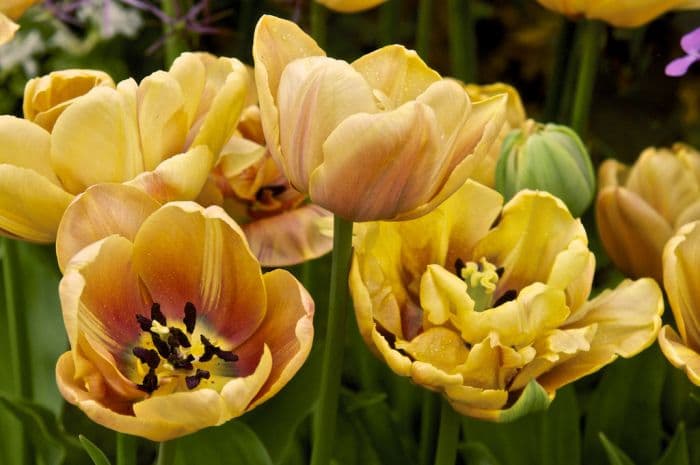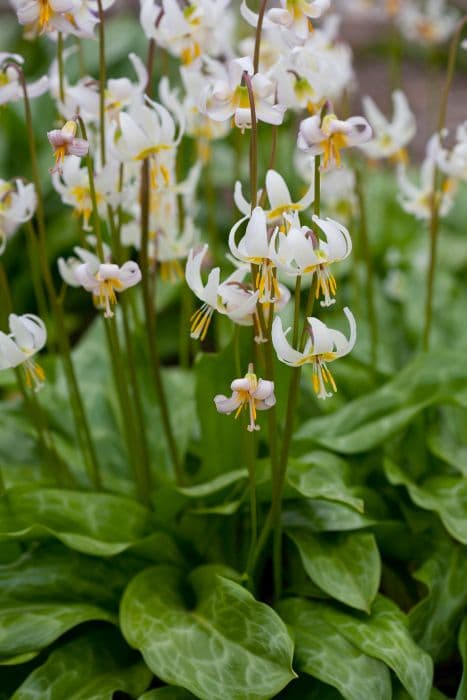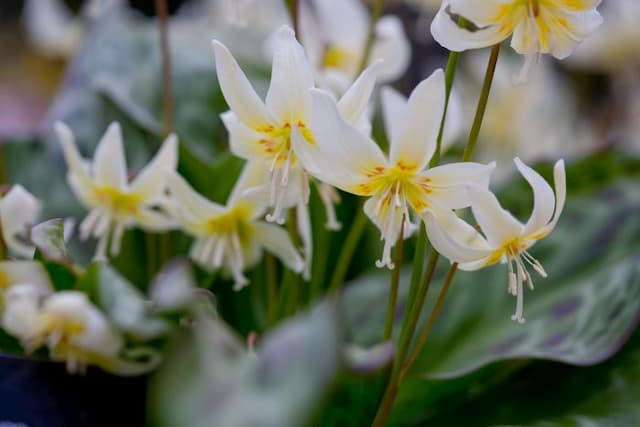Tulip 'La Belle Époque' Tulipa 'La Belle Époque' (2)

ABOUT
'La Belle Époque' bears flowers in shades of apricot and pale bronze with black anthers. Reaches a height of around 45cm while flowering in late spring
About this plant
 Names
NamesFamily
Liliaceae
Synonyms
La Belle Époque Tulip, Peony Flowering Tulip
Common names
Tulipa 'La Belle Époque'
 Characteristics
CharacteristicsLife cycle
Perennials
Foliage type
Deciduous
Color of leaves
Green
Flower color
Mixed
Height
1-2 feet (30-60 cm)
Spread
6 inches (15 cm)
Plant type
Bulb
Hardiness zones
3-8
Native area
Central Asia
Benefits
 General Benefits
General Benefits- Aesthetic Appeal: The Tulip 'La Belle Époque' is known for its beautiful pastel-colored flowers that can add elegance and charm to any garden or floral arrangement.
- Seasonal Interest: Blooming in spring, it provides a seasonal highlight in the garden when many other plants are just emerging from dormancy.
- Pollinator Attraction: While it is not specifically known for attracting pollinators, tulips in general can draw in bees and other beneficial insects during their bloom period.
- Easy to Grow: Tulips are considered easy to cultivate, requiring minimal maintenance, which makes them suitable for novice gardeners.
- Bulb Perennial: As a bulbous plant, it can reappear for several seasons if the bulbs are cared for properly, representing a long-term investment for gardeners.
- Versatility in Landscaping: Tulips can be planted in beds, borders, and containers, making them versatile for various garden designs and spaces.
- Cut Flower Use: Tulips are popular as cut flowers and can last for up to a week in vases, allowing for indoor enjoyment of their blooms.
- Hybrid Vigor: Being a hybrid variety, 'La Belle Époque' may exhibit greater vigor and resistance to some environmental stressors compared to non-hybrid species.
- Heritage and Hybrid Interest: For enthusiasts and collectors, the unique coloring and form of 'La Belle Époque' represents a particularly interesting variety due to its distinct attributes and hybrid status.
 Medical Properties
Medical PropertiesThis plant is not used for medical purposes.
 Air-purifying Qualities
Air-purifying QualitiesThis plant is not specifically known for air purifying qualities.
 Other Uses
Other Uses- Tulips like 'La Belle Époque' can be used to create natural dyes for fabrics, with petals providing a range of colors from soft pinks to rich yellows depending on the mordant used.
- The sturdy stems and blooms of tulips can be incorporated into floral art installations, offering a unique texture and form that can be maintained for the duration of an exhibit.
- Tulip petals have been used in culinary presentations as edible decorations for their color and mild flavor, often seen adorning salads or desserts.
- The bulb of the tulip can be hollowed out and used as a natural container for small-scale floral arrangements or as biodegradable seed planters.
- In historical times, tulip bulbs were sometimes used as a bartering tool or a form of currency, trading much like valuable commodities.
- Tulips can be used in perfumery, as their petals can impart subtle floral notes to a perfume blend when oils are extracted through enfleurage.
- 'La Belle Époque' tulips can serve as inspiration for artists and designers, who might use the form and color of the flower in their creative works, from fashion to graphic design.
- The tulip blossom's shape and structure lend themselves to being used as natural stencils in DIY craft projects for both children and adults.
- During blooming season, tulip fields like those with 'La Belle Époque' can attract tourists, thus supporting local economies through agrotourism.
- In some educational settings, the life cycle of a tulip can be used as a practical teaching tool for students learning about plant biology and horticulture.
Interesting Facts
 Feng Shui
Feng ShuiThe tulip is not used in Feng Shui practice.
 Zodiac Sign Compitability
Zodiac Sign CompitabilityThe tulip is not used in astrology practice.
 Plant Symbolism
Plant Symbolism- Eternal Love: The tulip, more generally, is often associated with deep and enduring love, making 'La Belle Époque' a symbol of everlasting affection.
- Royalty: This variety, with its luxurious hue and elegant form, represents regal presence and exquisiteness.
- Prosperity: The full, rounded blooms of the tulip signify abundance and prosperity, reflecting the richness of the 'La Belle Époque' period.
- Rebirth: 'La Belle Époque' tulips bloom in spring, making them a symbol of new beginnings and the rejuvenation that comes with the season.
- Perfect Love: The tulip's historical association with the tale of Farhad and Shirin, a classic story of love in Persian literature, underscores its connection to perfect, undying love.
 Water
WaterTulips generally require moderate watering, and 'La Belle Époque' tulips are no exception. They should be watered thoroughly when the soil feels dry to the touch. During the growing season, this is typically once a week, though it can vary with weather conditions. Provide about half a gallon of water for each square foot every week during active growth, ensuring that water penetrates deeply into the soil. Once the tulip flowers have faded and the leaves begin to yellow, reduce watering as the bulbs enter a dormant state.
 Light
LightTulips like 'La Belle Époque' thrive best in full sunlight. They need at least six hours of direct sunlight daily, so a spot that receives ample morning or afternoon sun is ideal. Avoid planting in areas that are heavily shaded as tulips will not bloom as prolifically without sufficient light.
 Temperature
Temperature'La Belle Époque' tulips prefer cooler temperatures and are hardy in USDA zones 3 through 8. They can survive winter temperatures as low as -40°F but need a period of cold dormancy at around 35 to 55°F for bud formation. The ideal growing temperature range for tulips during the spring is between 60 to 70°F.
 Pruning
Pruning'La Belle Époque' tulips don't require traditional pruning but deadheading after blooms fade encourages the plant to send energy to the bulb rather than seed production. Remove the flower head but leave the foliage intact until it naturally dies back to ensure nutrients are absorbed by the bulb. The best time for this is when the petals of the flowers begin to wilt and fall.
 Cleaning
CleaningAs needed
 Soil
SoilTulips thrive in well-draining, fertile soil with a pH between 6.0 and 7.0. For 'La Belle Époque', a mix of one-third garden soil, one-third compost or well-rotted manure, and one-third sharp sand or perlite will promote healthy growth and flowering.
 Repotting
RepottingTulips, including 'La Belle Époque', are typically grown from bulbs that do not require repotting. Plant bulbs in autumn and after they bloom in spring, allow them to die back naturally before digging up and storing or discarding.
 Humidity & Misting
Humidity & Misting'La Belle Époque' tulips prefer outdoor conditions with average garden humidity. They do not require specific humidity levels as long as they have proper soil moisture.
 Suitable locations
Suitable locationsIndoor
Grow Tulip 'La Belle Époque' in a bright, cool spot with well-draining soil.
Outdoor
Plant Tulip 'La Belle Époque' in autumn in well-drained soil in full sun.
Hardiness zone
3-8 USDA
 Life cycle
Life cycleTulipa 'La Belle Époque', commonly known as Tulip 'La Belle Époque', begins its life as a bulb, which is planted in the fall before the first frost. In the spring, the bulb sprouts and produces stem, leaves, and a bud, using the stored energy within the bulb to grow. The plant flowers in mid to late spring, displaying its characteristic pastel-colored blooms that attract pollinators. After flowering, the plant enters a senescence stage where the foliage begins to yellow and die back as the plant's energy is redirected back into the bulb for the next growing season. Throughout the summer, the bulb lies dormant underground. As temperatures cool down again in autumn, the cycle prepares to restart, with the bulb able to send up new growth the following spring.
 Propogation
PropogationPropogation time
Late summer
Tulipa 'La Belle Époque', commonly known as the tulip, is typically propagated through its bulbs. The best time for propagating this variety of tulip by bulb division is in the fall when the bulbs are dormant. After the tulip has finished flowering and the foliage has yellowed and died back, the bulbs can be gently lifted from the ground. These parent bulbs may have produced offsets, which are small bulblets that can be carefully separated from the main bulb. The offsets should be large enough to have a chance of flowering, usually around the size of a marble. Once separated, the offsets can be replanted immediately or stored in a cool, dry place until the optimal planting season arrives. The new bulbs should be planted at a depth of around 6 to 8 inches (15 to 20 centimeters) and spaced about 4 to 6 inches (10 to 15 centimeters) apart to allow for adequate room for growth.









